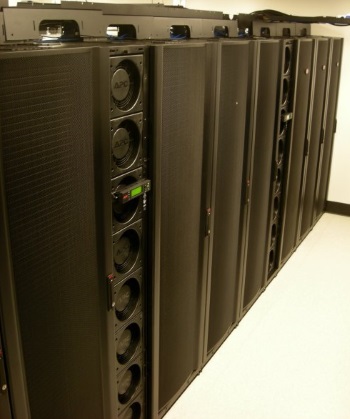Cooling efficiency is a top priority for today's data center operators. Increased data center densities enable operators to deliver more processing power in the same amount of space to meet the demands of cloud and hyper-scale environments. As more power is consumed per rack, however, heat becomes a big problem, and traditional computer room air conditioning (CRAC) units are unable to keep up.
Most modern data centers have adopted some sort of aisle-containment solution to minimize the mixing of hot and cold air. With cold-aisle containment, racks are positioned in rows with their fronts facing the aisle, which is enclosed to contain the cold intake air. Hot air from the rear of the equipment is exhausted into the room, which becomes a large hot-air plenum.

Close up view of the control panel on one of the InRow A/C units, which displays various
status and runtime information. Photo source: Sanity Technology sanitytechnology.com.au
A hot-aisle containment system mirrors this approach - the rears of the racks face the aisle, which contains the hot air and exhausts it into a drop ceiling void, return system or computer room air handler (CRAH). Hot-aisle containment is more efficient than cold-aisle containment because it leverages the fact that hot air rises. It also creates a more comfortable environment for data center staff and non-racked equipment.
Either way, aisle containment makes it possible to set cooling systems to a higher temperature while still maintaining a safe operating temperature for the equipment. It also minimizes the risk of hot spots, and reduces the need for humidification and dehumidification. All of this reduces costs by reducing power consumption.
However, aisle-containment with a CRAC unit is not as efficient as in-row cooling. As the name implies, in-row cooling places a cooling unit directly in the row of racks. The unit may be suspended from the ceiling, placed on top of a cabinet or mounted on the floor. Because the cooling unit is closer to the equipment, the cold air doesn't have to travel as far and heat can be dissipated faster. In-row cooling can be used to supplement room cooling, or installed in a closed-loop arrangement with a cold-aisle containment enclosure.
In-row cooling units may use refrigerant or chilled water, and incorporate fans to distribute the cold air. State-of-the-art units have built-in intelligence, varying cooling capacity and fan speeds according to the load.
There are several obvious used cases for in-row cooling. It may be used for a lab environment within a data center, or to provide more efficient cooling for a customer in a co-location facility. In-row cooling is also ideal for extremely dense environments, particularly those that use power-hungry GPU clusters for machine learning and other artificial intelligence applications.
In-row cooling units should be designed to meet customer demand for higher capacity to address today's heat loads. These units must fit comfortably in any data center environment for delivering maximum cooling capacity.
Marcus Doran is VP and General Manager at Rahi Systems Europe. He has over 20 years of experience in data center segment. He has extensive experience in data center infrastructure solutions contributing well-established relationships with the customers across the Northern European region.
More Networking Topologies Articles:
• Network Topologies
• Introduction to SONET (Synchronous Optical Networking)
• Cable: Cat5, Cat5e, Cat6, Cat6A ; What's the Difference?
• How Do Fiber Optic Couplers Work and How are They Made?
• Build Your Own Fiber Optic Network Like a Professional Network Engineer
• LAN Network Protocols - Ethernet, STP, Fiber
• Hubs, Switches and Routers - What's the Difference?
• Beginners Guide to Fiber Optic Bit Error Ratio (BER) Measurement
• Computer Network Routers, Hubs, and Switches
• Wireless Networking Infrastructure Mode

